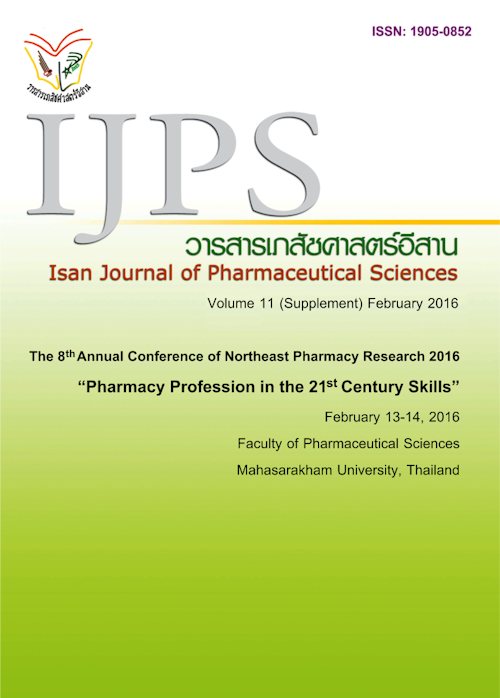Effect of Terpene on Physicochemical Properties and Skin Permeability of Capsaicin Loaded Solid Lipid Nanoparticles
Main Article Content
Abstract
Introduction: Capsaicin (CAP) is the major active compound of chili piper. Previous study has been
reported that CAP was used orally or topically for pain relief by rheumatism, neuralgia, lumbago or sciatica.
However, the significant first pass metabolism, the short half-life and the poor water solubility of CAP lead to its
limitation in the development of CAP formulations as novel pharmaceutical products. The objective of this study
was to investigate the effect of terpene on physicochemical properties and skin permeability of CAP loaded
solid lipid nanoparticles (SLN). Method: The SLN containing a constant amount of 0.15% CAP, cetyl palmitate,
transcutol P, Tween 20, Tween 80, deionized water and various percentage of terpene as a potential
penetration enhancer from 0 to 15% were prepared. SLN formulations were evaluated for physicochemical
properties (e.g. size, size distribution, zeta potential and entrapment efficiency), and skin permeability. The
terpene used in SLN formulations was defined as formulation factors (Xn), while the physicochemical properties
and skin permeability were defined as response variables (Yn). Results: The results indicated that the
percentage of terpene significantly affected the entrapment efficiency and skin permeability of SLN formulation.
The skin permeability of all SLNs was significantly higher than commercial product. The 10% terpene
incorporated in SLN showed the maximum entrapment efficiency and skin permeability. Conclusion: The
incorporation of terpene into the formulation was beneficial for the development of SLNs for enhanced
transdermal delivery of CAP. The optimal percentage of terpene used in SLN was up to 10%. We are success
in showing the effect of terpene on physicochemical properties and skin permeability of capsaicin loaded SLN.
Further study is required to confirm the influence of terpene on the stability of SLN.
Article Details
In the case that some parts are used by others The author must Confirm that obtaining permission to use some of the original authors. And must attach evidence That the permission has been included
References
Badran M, Shalaby K, Al-Omrani A, Influence of the flexible liposomes on the skin deposition of a hydrophilic model drug, carboxyfluorescein: dependency on their composition.The Scientific World J. 2012a; 2012: 9.
Badran M, Shazly GA, EL-Badry M, ffect of terpene liposomes on the transdermal delivery of hydrophobic model drug, nimesulide: characterization, stability and in vitro skin permeation.AJPP. 2012b; 6: 3018-3026.
Baranidharan G, Das S, Bhaskar A, A review of the high-concentration capsaicin patch and experience in its use in the management of neuropathic pain.Ther Adv Neurol Disord. 2013; 6(5): 287-297.
Bhushan S, Kakkar V, Pal HC, Guru SK, Kumar A, Mondhe DM, et al., Enhanced anticancer potential of encapsulated solid lipid nanoparticles of TPD: a novel triterpenediol from Boswellia serrata.Mol Pharm. 2013; 10(1): 225-235.
Charoenputtakhun P, Opanasopit P, Rojanarata T, Ngawhirunpat T, All-trans retinoic acid-loaded lipid nanoparticles as a transdermal drug delivery carrier.Pharm Dev Technol. 2014a; 19(2): 164–172.
Charoenputtakun P, Pamornpathomkul B, Opanasopit P, Rojanarata T, Ngawhirunpat T, Terpene composited lipid nanoparticles for enhanced dermal delivery of all-trans-retinoic acids.Biol Pharm Bull. 2014b; 37(7): 1139–1148.
Chourasia MK, Kang L, Chan SY, Nanosized ethosomes bearing ketoprofen for improved transdermal delivery.Results Pharma Sci. 2011; 1(1): 60-67.
Duangjit S, Opanasopit P, Rojanarata T, Ngawhirunpat T, Characterization and in vitro skin permeation of meloxicam-loaded liposomes versus transfersomre.J Drug Deliv. 2010; 2012, Article ID 418316, 9pages, doi:10.1155/2011/418316.
Fraenkel L, Bogardus Jr ST, Concato J, Wittink DR, Treatment options in knee osteoarthritis: the patient's perspective.Arch Intern Med. 2004; 164(12): 1299-1304.
Gao K, Jiang X, Influence of particle size on transport of methotrexate across blood brain barrier by polysorbate 80-coated polybutylcyanoacrylate nanoparticles.Int J Pharm. 2006; 310: 213-219.
Huang YB, Lin YH, Lu TM, Wang RJ, Tsai YH, Wu PC, Transdermal delivery of capsaicin derivative-sodium nonivamide acetate using microemulsions as vehicles.Int J Pharm. 2008; 349(1–2): 206-211.
Kedmi R, Ben-Arie N, Peer D, The systemic toxicity of positively charged lipid nanoparticles and the role of Toll-like receptor 4 in immune activation.Biomaterials. 2010; 31: 6867-6875.
Luo XJ, Peng J, Li YJ, Recent advances in the study on capsaicinoids and capsinoids.Eur J Pharmacol. 2011; 650(1): 1-7.
Martins SM, Sarmento B, Nunes C, Lúcio M, Reis S, Ferreira DC, Brain targeting effect of camptothecin-loaded solid lipid nanoparticles in rat after intravenous administration.Eur J Pharm Biopharm.2013; 85: 488-507.
Muller RH, Radtke M, Wissing SA, Solid lipid nanoparticles (SLN) and nanostructured lipid carriers (NLC) in cosmetic and dermatological preparations.Adv Drug Deliv Rev. 2002; 54 Suppl 1: S131-155.
Pathan I, CM S, Chemical penetration enhancers for transdermal drug delivery systems.Trop J Pharm Res. 2009; 8: 173-180


